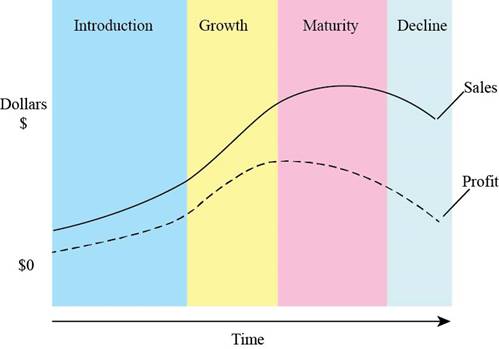
Concept explainers
To determine: The marketing characteristics of various products as well as the services at each stage of the product lifecycle.
Introduction: The product lifecycle deciphers various stages involved in the life cycle of the product that is between the time it enters the market and exit from it. The life cycle of a product includes four stages that are the introduction of a product in the market, growth, maturity of the product and the declining stage.
Answer to Problem 1PC
The characteristics of the products and the services in the marketplace at various stages of the product lifecycle are summarized in the table below:
| Introduction | Growth | Maturity | Decline | |
| Sales | Low | Rising | Peak | Declining |
| Profits | Negative to low | Rapidly rising | Peak to declining | Declining |
| Typical consumers | Innovators | Early adopters and early majority | Late majority | Laggards |
| Competitors | One or few | Few but increasing | The high number of competitors | The low number of competitors |
Table (1)
Explanation of Solution
The different stages of the product lifecycle are depicted in the figure given below:

Fig (1)
The first stage of the product lifecycle is the introduction stage of the product in the market where the sales, as well as the profits from the sale, is almost negligible. The innovators in the market are the only customers of the product and face competition from one or the other firm of its type.
The second stage is the growth of the product in the market and so it faces a rise in the sale and the profit margins. The customers are the early majority of the population that results in an increasing number of competitors of the product in the marketplace.
The third is the maturity stage of the product, the firm experiences the highest of the sales as well as the profit margins. Up to this level, the late majority fraction of population also joins the trail and thus the firm experiences the highest number of competitive firms in the marketplace.
The last stage is the sale, as well as the profit margin of the product, begins to decline and it then keeps on declining. The customers at this time are mainly the laggards and hence the firm has the least competition in the marketplace.
Therefore, it can be concluded that the different characteristics of the product, as well as the services in the market, are mainly the sale, profits, the customer base and the competition of firms with other firms in the market.
Want to see more full solutions like this?
Chapter 12 Solutions
Loose Leaf for M: Marketing
- General Motors buys engines for use in its vehicles from BorgWarner, which in turn buys many of the vehicles it needs from GM. This is an example of: Question 20Select one: a. nested demand. b. derived demand. c. reciprocity. d. elastic demand. e. circular buying.arrow_forwardLooking for some insight on a scenario involving a car company that sells a full range of vehicles—from large trucks and luxury SUVs to economy cars and hybrids. Recently, there’s been a noticeable shift in consumer buying habits, and management is interested in developing a system to track early trends in the marketing environment. The goal is to explore two of the following areas: Key variables in the marketing environment that should be monitored to help recognize and predict trends. The importance of tracking these specific variables over time. Effective methods for monitoring these trends. How marketing research can help reveal how consumer perceptions of these trends influence vehicle choices. Open to hearing thoughts or approaches on any two of these points.arrow_forwardMeasuring Online success Google analytics and other enterprise systems like Omniture are great in assisting companies in obtaining leads and using data collected to assist companies improve their websites. For this assignment take a look at the success stories from companies using google analytics. Click on the link below to choose a success story, once on the website make sure to click on the PDF file to view the sample company of your choice. https://www.google.com/analytics/success-stories/?product=analytics#?modal_active=none Name of the company ? About the company What are some of the company goals? What was the approach in using google analytics to help the company succeed? What was the end results from using Google analytics?arrow_forward
- Answer the following question on business market, then compare how business markets differ from consumer markets. What is Business Marketing? What would make a business product? Provide an example What is relationship Marketing, name some strategic alliance in business marketing? Name Some differences in Business VS Consumer markets and provide an example of each 1. 2. 3. 4. 5. Name an organization in Business market and provide example of what products they offer and who may be their clients? Name an organization in Business market and provide example of what products they offer and who may be their clients?arrow_forwardConsumer Buying Decision influences There are several factors that influence the consumer buying decision. For this assignment find a product advertisement and address the influencing factors present. PRODUCT: 2. SLOGAN: 3. Provide a copy of the advertisement for this product (Ad print picture, or YouTube video link) 4. Discuss in 5 sentences or more, the influencing factors present in your product advertisement: (Culture, individual, social, or psychological) how can you tell?arrow_forwardOur company, XYZ Corp, is a leading innovator in the field of office furniture, with a special focus on ergonomics and technology integration. Our product, the AI-powered smart standing desk, is a state-of-the-art piece of office furniture that combines the health benefits of a standing desk with the convenience of AI technology. The desk can adjust its height automatically based on the user's preference, and it also features integrated charging ports, a digital display for reminders and notifications, and voice control capabilities. The advantages of our product include improved health and productivity for users, convenience, and a modern, sleek design. The product's features include automatic height adjustment, integrated charging ports, a digital display, and voice control. In the future, we may consider expanding our product line to include other smart office furniture, such as chairs and storage solutions, for the Vietnamese market. The marketing mix refers to a company's set of…arrow_forward
- For the following assignment reference a recent purchase you have made and explore the several steps in the consumer decision making process for this purchase. What product did you purchase? Need Recognition Need or want, how did you assess the need? 3.Information Search What is the extent of your search for product information? Did you ask friends, family, reviews? Online research? 4. Evaluation of alternatives Which other alternatives did you consider (other brands)? 5. Purchase Did you make the purchase immediately or did you take time to make a final decision? Where was the purchase made, in store or online? Was the product available immediately or did you have to wait for your purchase to arrive? 6. Post purchase behavior Discuss any generated cognitive dissonance by this purchase. What was done to address the situation. What role, if any, did marketing play in minimizing cognitive dissonance?arrow_forwardFind a company that has gone global. Research details of a multinational company. Copy the Organization website link here: Who is the organization? What is the product or service? Are there any changes in the product or services in the various locations? What are some of the External Environment Factors Facing this global Market? Example: Culture? Natural resources? Economic & Technological Development? Political Structure? Demographic Makeup? What is the economic development of the majority of the countries your company is present in? Developed or less developed Country? How is this company using Social Media to reach their global Marketing? Provide a sample of the global advertising for this company, provide a picture or a video.arrow_forwardNow, you are working on the last section of your Portfolio Project. This week you will complete the following: You have proven to the management team that you have carefully considered the cultural aspects of expanding the business into a new country. They would like to hear your specific plans for ensuring operational success in their next meeting. Prepare a report addressing the following topics: Strategic Management: Discuss the critical factors of the Strategic Management Process important to successful operations in your country. Organizational Structure: Discuss the type of organizational structure that will be most effective in the new location including the manufacturing facility. Control and Monitoring Systems: Discuss your plan for control and monitoring systems issues for the expansion and operations within the manufacturing facility. Staffing and Compensation: Discuss how you will staff the operation and how you will compensate the employees and any training that will…arrow_forward
- Economic growth has slowed in recent years in many developed markets. In order to continue growing, large corporations are expanding into international emerging markets, such as China and India. And while some are targeting a new emerging middle class in these regions, many corporations like Procter & Gamble (P&G), Panasonic, and Unilever are searching for ways to reach a largely untapped demographic: the global poor who live on less than $2 per day. As discussed in the chapter, single- or small-use packaging has been a popular strategy for Unilever and other multinationals in rural and emerging markets. Other companies have tried to simplify more complex and costly designs to drive prices down for poor consumers. However, simplifying design and lowering other costs has not been enough to successfully penetrate the lowest level of the economic pyramid. Panasonic’s head of overseas consumer products, Hitoshi Otsuki, said that, “If it starts with a Japanese product or Japanese…arrow_forwardCulture refers to the common set of values shared by its citizens that determine what is socially acceptable. For this assignment explore some of the key characteristics of a specific culture. You can choose a country of your choice and research as much details about their culture as possible, don’t forget to include visuals. What country? What is the language and culture Idioms? Describe their customs and traditions? What re the important values of this culture? Summary: What do you think would be some expectations for anyone doing sales presentations in this country? Notes and references:arrow_forwardWhat is a good response to this statement? As we know, several global retailers target densely populated regions such as China or India as they represent emerging markets and great potential for maximum profits. As many have stated in this discussion, these retailers tend to exploit workers in these regions by utilizing the nation's lax labor laws, health and safety standards, as well as their lack of rights within the region. However, some do not discuss the cultural appropriation or pandering that these companies exercise in an effort to maximize their profits. There are instances of companies utilizing cultural elements such as symbols, traditional designs, or culturally significant images on mass produced items without understanding the meaning or showing respect to that significant meaning. Retailers sometimes utilize these culturally significant images or symbols to maximize their profits without acknowledging where it comes from or giving back to the community they took it from.…arrow_forward
- MarketingMarketingISBN:9780357033791Author:Pride, William MPublisher:South Western Educational Publishing
 Contemporary MarketingMarketingISBN:9780357033777Author:Louis E. Boone, David L. KurtzPublisher:Cengage Learning
Contemporary MarketingMarketingISBN:9780357033777Author:Louis E. Boone, David L. KurtzPublisher:Cengage Learning Foundations of Business - Standalone book (MindTa...MarketingISBN:9781285193946Author:William M. Pride, Robert J. Hughes, Jack R. KapoorPublisher:Cengage Learning
Foundations of Business - Standalone book (MindTa...MarketingISBN:9781285193946Author:William M. Pride, Robert J. Hughes, Jack R. KapoorPublisher:Cengage Learning  Foundations of Business (MindTap Course List)MarketingISBN:9781337386920Author:William M. Pride, Robert J. Hughes, Jack R. KapoorPublisher:Cengage Learning
Foundations of Business (MindTap Course List)MarketingISBN:9781337386920Author:William M. Pride, Robert J. Hughes, Jack R. KapoorPublisher:Cengage Learning



